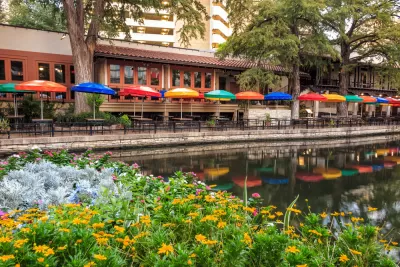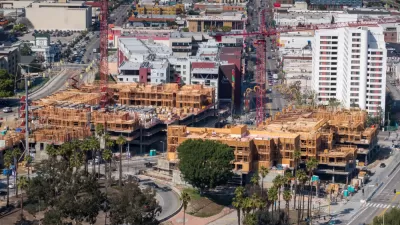A closer look at the data reveals a country that continues to sprawl.

Jed Kolko lays out his argument for a post a New York Times Upshot article:
Be skeptical when you hear about the return to glory of the American city — that idealized vision of rising skyscrapers and bustling, dense downtowns. Contrary to perception, the nation is continuing to become more suburban, and at an accelerating pace. The prevailing pattern is growing out, not up, although with notable exceptions.
According to Kolko's analysis, "[r]ural areas are lagging metropolitan areas in numerous measures, but within metro areas the suburbs are growing faster in both population and jobs."
Kolko presents a number of infographics to make an unavoidable point: most metropolitan areas in the country have become less urban (defined by density) during this decade. Exceptions include Seattle, Chicago, and Minneapolis at the top of the list of cities growing the most dense between 2010 and 2016. Meanwhile San Antonio, Austin, and Oklahoma City lead the trend toward less dense living. Kolko also locates a trend within the urbanization trend: already dense metros are getting denser. Thus, Kolko forgives those propagating the perception that the entire country is urbanizing: "metro areas that are urbanizing have more than their fair share of urban planners, including Seattle, Minneapolis, Washington and Boston. Those who write about, advocate for and choose to live in cities really do see more urbanization around them."
Kolko's argument echoes that of an earlier article by Alon Levy, which took San Diego County, in California, as its case study for the same suburbanization trend.
FULL STORY: Seattle Climbs but Austin Sprawls: The Myth of the Return to Cities

Alabama: Trump Terminates Settlements for Black Communities Harmed By Raw Sewage
Trump deemed the landmark civil rights agreement “illegal DEI and environmental justice policy.”

Study: Maui’s Plan to Convert Vacation Rentals to Long-Term Housing Could Cause Nearly $1 Billion Economic Loss
The plan would reduce visitor accommodation by 25% resulting in 1,900 jobs lost.

Why Should We Subsidize Public Transportation?
Many public transit agencies face financial stress due to rising costs, declining fare revenue, and declining subsidies. Transit advocates must provide a strong business case for increasing public transit funding.

Paris Bike Boom Leads to Steep Drop in Air Pollution
The French city’s air quality has improved dramatically in the past 20 years, coinciding with a growth in cycling.

Why Housing Costs More to Build in California Than in Texas
Hard costs like labor and materials combined with ‘soft’ costs such as permitting make building in the San Francisco Bay Area almost three times as costly as in Texas cities.

San Diego County Sees a Rise in Urban Coyotes
San Diego County experiences a rise in urban coyotes, as sightings become prevalent throughout its urban neighbourhoods and surrounding areas.
Urban Design for Planners 1: Software Tools
This six-course series explores essential urban design concepts using open source software and equips planners with the tools they need to participate fully in the urban design process.
Planning for Universal Design
Learn the tools for implementing Universal Design in planning regulations.
Smith Gee Studio
Alamo Area Metropolitan Planning Organization
City of Santa Clarita
Institute for Housing and Urban Development Studies (IHS)
City of Grandview
Harvard GSD Executive Education
Toledo-Lucas County Plan Commissions
Salt Lake City
NYU Wagner Graduate School of Public Service





























